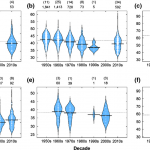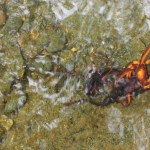Salamanders can be a proxyindicator for climate change. Changes in salamanders have been linked to climate changes during ancient times, and in a very recent study, salamanders in the US Appalachians seem to have changed in relation to anthropogenic global warming. In fact, the changes observed in these Appalachian salamanders is quite large, very rapid, and thus, alarming. I’m going to describe this study in some detail, and as a bonus for sticking with me on this, I’ll throw in some entertaining Climate Science Denialism near the end. As an additional bonus prize, you’ll get a nice new…
Amphibians
With springtime comes the urge to head to the river. These California newts are obeying urges of their own. Also known as Taricha torosa, this newt is an amphibian and a member of the Salamander family.
Just as beautiful as the newts is the surface of the water. I wish I could breathe under water!
I counted more than a hundred of these along a small creek that flows into the Yuba river. According to Wikipedia, these animals are land-dwelling for the hotter parts of the year, but prefer "slow-moving water" while breeding. Between December and May, they can…
On ERV, Abbie Smith reports that scientists have discovered an entirely new branch of viruses in the boiling acid pools of Yellowstone National Park. By analyzing RNA segments from the pools, researchers inferred the existence of positive-strand RNA viruses with unknown genetic configurations. Smith writes, “These viruses are not just kinda new. They are really really different from the RNA viruses we already know about!” They infect primordial single-celled organisms called Archaea which thrive in the extreme heat of the pools. On the multicellular side of life…
Nearly one-third of the world's amphibian species are at risk of extinction. The rescue project aims to save more than 20 species of frogs in Panama, one of the world's last strongholds for amphibian biodiversity. While the global amphibian crisis is the result of habitat loss, climate change and pollution, chytridiomycosis is likely at least partly responsible for the disappearances of 94 of the 120 frog species thought to have gone extinct since 1980.
Read more about the Panamanian Amphibian Rescue and Conservation Project, and check out their blog, here.
(h/t Smithsonian Institution)
The skeleton of Palaeobatrachus from Lake Enspel, Germany. From Wuttke and Poschmann, 2010.
In On the Origin of Species, Charles Darwin said of the fossil record:
For my part, following out Lyell's metaphor, I look at the natural geological record, as a history of the world imperfectly kept, and written in a changing dialect; of this history we possess the last volume alone, relating only to two or three countries. Of this volume, only here and there a short chapter has been preserved; and of each page, only here and there a few lines. Each word of the slowly-changing language, in which…
tags: evolution, evolutionary biology, behavioral ecology, animal behavior, molecular ecology, parental care, mating systems, monogamy, sexual selection, frogs, poison dart frogs, Dendrobatidae, Ranitomeya, researchblogging.org,peer-reviewed research, peer-reviewed paper, journal club
Peruvian mimic poison frog, Ranitomeya imitator.
Image: Jason Brown [larger view]
To know the breeding system is to know the genetic architecture of a species.
To know the evolution of a breeding system is to know how evolution works ..
~ Lewis & Crowe, Evolution (1955)
Genetic tests have revealed the…
tags: Life, Discovery Channel, Reptiles and Amphibians, Waterfall Toad Leap from Danger, animals, mammals, birds, BBC, television, streaming video
Gail Weiswasser at the Discovery channel emailed a few days ago to tell me about TONIGHT's premiere on the Discovery Channel of BBC's LIFE, the 11-part follow up to PLANET EARTH (the most successful natural history documentary of all time). While PLANET EARTH told the story of the natural world through the framework of our planet's ecosystems and regions, LIFE takes us on a more intimate journey, introducing different animal and plant groups, using…
Not Exactly Pocket Science - panic aboard the Titanic, the rise of polar bears and emasculated frogs
I'm trying something new. Right from the start, I've always tried to write fairly long and detailed write-ups of new papers but this means that on any given week, there are always more stories than time and my desktop gets littered with PDFs awaiting interpretation.
So, I'm going to start doing shorter write-ups of papers that don't make the cut, linking to more detailed treatments on other quality news sources. This is something that I hope science journalists will do more of. It stems from a Twitter conversation where I asked if I should (a) write up short versions of these stories, (b)…
Toads are an evolutionary success story. In a relatively short span of time, they diversified into around 500 species and spread to every continent except Antarctica. Now, Ines van Bocxlaer from Vrije University has uncovered the secrets of their success. By comparing the most home-bound toads with the most invasive ones, she has outlined seven qualities that enabled these amphibians to conquer the world. In a common ancestor, these seven traits came together to create an eighth - a pioneer's skill are colonising new habitats.
Some, like the harlequin toads, are restricted to such narrow…
A red eft (Notophthalmus viridescens), photographed near High Point, New Jersey
tags: art, wildlife art, stop-motion painting, Riparian Rashomon, Agami Heron, Agamia agami, Brilliant Forest Frog, Lithobates warszewitschii, entertainment, Carel Brest van Kempen, streaming video
This is a fascinating stop-motion video of the creation of artist Carel Brest van Kempen's painting, Riparian Rashomon. This is a diptych (two-panel) piece, vertically oriented. The upper panel is painted first, then the lower one, and finally the two are brought together as intended. Each panel depicts a different viewpoint of the same event: a Brilliant Forest Frog evading an Agami Heron in a…
tags: art, wildlife art, stop-motion painting, Call of the Flood, Poison Rock Frog, entertainment, Carel Brest van Kempen, streaming video
This is another fascinating stop-motion video documenting the creation of artist Carel Brest van Kempen's painting, Call of the Flood. Here, a male Poison Rock Frog, a common Southeast Asian species, calls from a flooded spiny bamboo.
Carel Brest van Kempen published a stunning book, Rigor Vitae: Life Unyielding [my review] and writes the art blog that goes by the same name, that might be of interest to you.
tags: art, wildlife art, stop-motion painting, Northern Casque-headed Treefrog, entertainment, Carel Brest van Kempen, streaming video
This is another fascinating stop-motion video by artist Carel Brest van Kempen. This video documents the creation of an acrylic painting of an unusual Panamanian frog, the Northern Casque-headed Treefrog.
Carel Brest van Kempen published a stunning book, Rigor Vitae: Life Unyielding [my review] and writes the art blog that goes by the same name, that might be of interest to you.
This is the last animal we saw on our South African safari, and we found it sitting on top of our conditioner. Thank goodness it wasn't a leopard.
I reckon it's a foamy nest frog, so named for its tendency to lay its eggs into a nest of foamy bubbles overhanging a body of water. I always thought this species had a darker colour but apparently, they become almost white in bright sunlight. Charming little tyke, isn't it?
At last long there was solid proof that humans had died in a real Noachian Deluge. That such an event had occurred was widely taken on faith by Christians, and the belief that world's geology had been formed by the Flood was assented to by many naturalists, but in 1725 the Swiss naturalist Jacob Johann Scheuchzer believed that he had discovered a symbol so instantly recognizable that no one could doubt that the biblical catastrophe was real. It was what appeared to be a human skeleton, cleaved nearly in half but nonetheless preserved by the very floodwaters that had killed the sinner.
The…
The British Wildlife Centre is one of my favourite places in the country. It's like a small zoo focusing solely on British wildlife and everything in it lives in lovely open enclosures with naturalistic environments (the otters have about three lakes to play around in). It's a fantastic place to visit, especially for people who've most likely only ever seen a badger or a fox as a roadside carcass. Here are some photos from yesterday's trip:
Badger
Buzzard
Eagle owl
Frog (pool frog?)
Harvest mouse (note size of blackberry for comparison)
Otter
Wotta lotta otter
Pine marten (Britain rocks for…
A red eft (Notophthalmus viridescens), photographed near High Point, New Jersey.
A red eft (Notophthalmus viridescens), photographed near High Point, New Jersey.
A bullfrog (Lithobates catesbeiana), photographed in Westchester County, NY.
An American toad (Bufo americanus), photographed along the Appalachian Trail in New Jersey.

